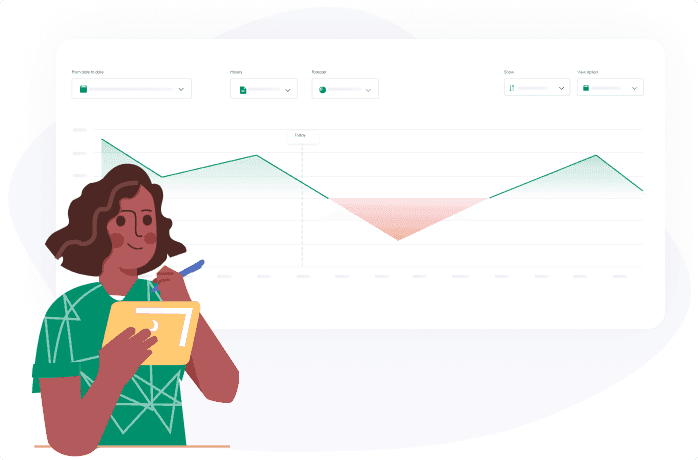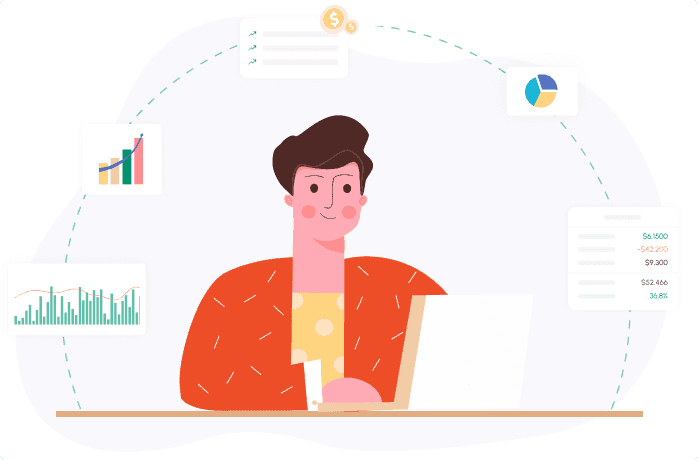What is negative cash flow and what to do about it?

What does a negative cash flow mean? It indicates that your company is spending more money than it is making.
Although it may appear simple, the consequences could be severe.. Payroll can slip, inventory runs short, and growth plans get delayed.
It’s a common issue, especially for fast-growing businesses or those waiting on overdue payments. Even strong revenue doesn’t always mean cash is available when you need it.
In this article, we’ll dig into the negative cash flow meaning, break down the definition of negative cash flow, and walk through real-world strategies for how to improve negative cash flow and keep your business moving forward, without scrambling for cash.
What is Negative Cash Flow?
Understanding the negative cash flow meaning can give you a sharper edge in making financial decisions. It’s not just an accounting metric. It’s a day-to-day reality check: Do you have the money in hand to meet your needs?
Simple Explanation of Negative Cash Flow
So, what is negative cash flow, really? It’s when your outgoing expenses are higher than what you’re actually bringing in. That doesn’t automatically mean you’re losing money. A lot of the time, it’s just timing — cash hasn’t landed yet, but the bills are due.
Here’s a negative cash flow example: You bill a client $15,000, but the payment won’t hit your account for two months. Meanwhile, you’ve already spent $16,500 on essentials like payroll and rent. On paper, revenue may seem good, but in reality, you're short.
That’s the negative cash flow definition: more money is leaving your account than coming in during a given time period.
How Cash Flow Differs from Profit
Profit and cash flow aren’t the same thing — not even close. Profit is the number you see once you've deducted all expenses from your sales. But cash flow focuses on when the money actually moves in or out of your account.
You could technically be profitable and still run into negative cash flow if your income is delayed or if your biggest bills are due before clients settle up. Profit might tell you the business is working. Your cash flow indicates if you have enough money to maintain operations.
When is Negative Cash Flow a Serious Problem?
A few cash crunches here and there? That’s normal. But if your business constantly spends more than it earns, and you're depending on loans or credit cards to stay afloat, that’s a red flag.
Long-term or unexplained negative cash flow can lead to missed payments, stressed-out employees, and halted operations. So, is negative cash flow bad? The longer it goes unchecked, the harder it gets to fix — and the more dangerous it becomes for your company’s future.
 Image source: Freepik
Image source: Freepik
Common Causes of Negative Cash Flow
If you know what to watch for, you can usually catch cash flow problems before they spiral. Here are some of the most common culprits behind negative cash flow:
Slow Customer Payments & Late Invoices
You’ve made the sale, but the cash is nowhere in sight. Sound familiar? Long payment terms — net-60, net-90 — without tight follow-up can leave you cash-starved, even if business looks good on paper.
High Operating Costs Eating Up Cash
Rent, payroll, subscriptions, utilities — these things add up quickly. When they’re not kept in check, even steady income can feel like it’s vanishing into thin air. That’s how overhead eats through your cash reserves.
Overstocking Inventory & Poor Stock Management
Here’s another real negative cash flow example: You invest $25,000 in inventory expecting fast turnover, but sales don’t move. That cash gets tied up in stock you can’t liquidate — and meanwhile, bills keep coming.
Business Expansion Without Proper Planning
Growth is great — until it isn’t. Expanding too soon without forecasting cash needs can lead to negative cash flow, even when the big picture looks promising. Always make sure your growth has financial support, not just ambition.
Seasonal Sales Fluctuations
Some industries boom for a few months, then slow down. If your strategy only works in the busy season, you’re setting yourself up for gaps in cash flow when sales dip.
Unexpected Expenses or Emergencies
A broken piece of equipment. A surprise tax penalty. A legal bill. All it takes is one unplanned cost to throw your balance off, especially if you don’t have a cushion.
How to Identify Negative Cash Flow in Your Business
Sometimes the signs are obvious. Other times, they creep in slowly. Watch for these common red flags that negative cash flow is becoming a problem:
- You’re chasing payments just to make payroll
- You rely more and more on short-term loans or credit cards
- Operating costs are stable, but your bank balance keeps shrinking
- You’re delaying growth decisions out of fear that you’ll run out of cash
If any of this rings true, your business might already be in a cash crunch, and it’s time to act.
How to Fix Negative Cash Flow?
If you’re wondering how to improve negative cash flow, the key is to act early — and with strategy, not panic. These actions will assist you in getting back on course.
- Speed up payments: Invoice right away. Follow up regularly. Offer early-payment incentives (like 2% off if paid within 10 days).
- Cut the fat: Review every expense. If it’s not delivering results, cut it or renegotiate the price.
- Clear out old inventory: Bundle, discount, or run a flash sale to move stock and bring in fast cash.
- Extend vendor terms: If you can stretch payments from 30 to 60 days, you give yourself more breathing room.
- Use financing carefully: If needed, use invoice factoring or a short-term credit line. Just make sure repayment is part of your forecast.
Smart Strategies to Prevent Negative Cash Flow
How should negative cash flow be managed? Avoid it altogether. Prevention beats repair every time. Here’s how:
- Forecast frequently: Monthly and quarterly cash flow forecasts help you spot problems before they hit.
- Align spending with income: Make an effort to schedule major purchases during times when you make the most money.
- Build a reserve: A cash buffer of at least 3 months of operating expenses can save you in a downturn.
- Grow at the right pace: Make sure your cash flow can support your next move — don’t grow just because you can.
The Effects of Negative Cash Flow on Your Company
Is it possible for cash flow to be negative even while you're profitable? Indeed, and the consequences are genuine.
Here’s what’s at stake:
- Late payments to suppliers strain relationships and disrupt deliveries
- Payroll issues cause stress and turnover
- You miss out on opportunities because you can’t fund them
- Investors and lenders get nervous
- Your reputation takes a hit, even if your numbers look good
 Image source: Freepik
Image source: Freepik
Important Lessons: Maintain Control Over Your Cash Flow
Cash flow isn’t just a financial metric — it’s how your business stays functional and flexible. When you understand how and when money moves in and out, you can make better decisions, avoid unnecessary risk, and seize opportunities with confidence.
Here’s a quick recap to keep top of mind:
- What is negative cash flow? It’s when your business spends more than it brings in during a certain period
- What does a negative cash flow mean? Even with strong revenue, your business could be financially vulnerable
- Causes range from delayed payments to bad timing and unchecked costs
- You need visibility, discipline, and the right tools to fix it
- Remember: sales matter, but available cash is what keeps you alive
Software & Tools to Manage Your Cash Flow
Most cash flow problems aren’t caused by a lack of income — they’re caused by a lack of visibility. That’s why tools like Cash Flow Frog, a leading cash flow forecasting software, can make all the difference. Here’s how it helps:
- Consolidate data from multiple entities into one clear forecast
- Track customer insights to improve collections
- Examine the differences between your intended and actual outcomes.
- Run “what-if” scenarios to test your next move
- Plan ahead — up to three years out
- View daily, weekly, monthly, or quarterly cash flow snapshots
- Factor in VAT/GST for better accuracy
- Share beautiful, customizable reports with stakeholders.
When is negative cash flow good? When it’s planned. Instead of reacting to cash gaps, you’ll see them coming — and make smarter decisions ahead of time.
Concluding Remarks: Manage Your Cash Flow
Although ignoring negative cash flow can lead to failure, it is not an indicator of failure. Whether your business is growing rapidly or operating with a lean model, the ability to monitor, understand, and adjust your cash flow is one of the most important financial habits you can build.
The more visibility you have, the more confident you’ll feel making informed decisions in achieving your business goals. So, track often. Forecast early. Act decisively. Because when you manage your cash flow with intention, you’re not just staying afloat — you’re building a business that’s resilient, agile, and ready for what’s next.

Current Liabilities: Meaning, Examples, and How to Calculate Them
Read more

What Is a Finance Charge? A Simple Explanation You’ll Actually Use
Read more

Current Assets Explained: Meaning, Types, and How They Work
Read more

Cash Flow Forecasting Template
Read more

Your Guide To Financial Metrics And KPIs
Read more

10 Cash Management Trends for 2026
Read more
FAQ
Trusted by thousands of business owners
Start Free Trial Now